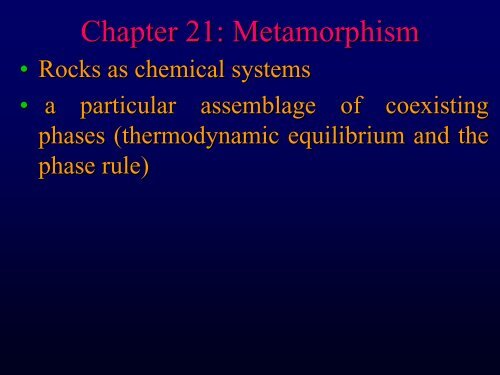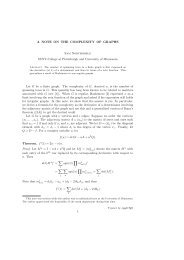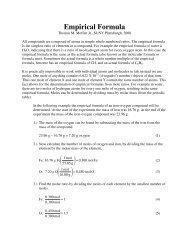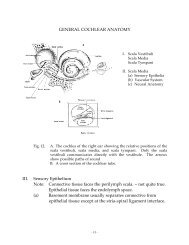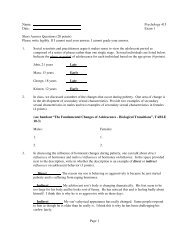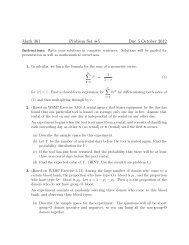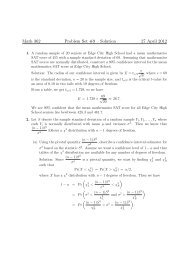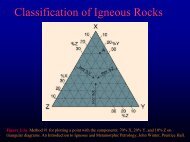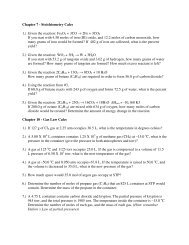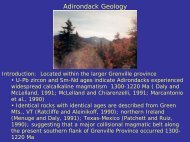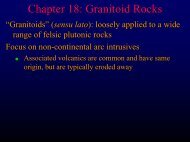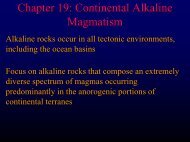Chapter 21: Metamorphism - Faculty web pages
Chapter 21: Metamorphism - Faculty web pages
Chapter 21: Metamorphism - Faculty web pages
You also want an ePaper? Increase the reach of your titles
YUMPU automatically turns print PDFs into web optimized ePapers that Google loves.
The Limits of <strong>Metamorphism</strong>• Low-temperaturelimit grades into diagenesis The boundary is somewhat arbitraryDiagenetic/weathering processes are indistinguishable frommetamorphic <strong>Metamorphism</strong> begins in the range of 100-150150 o C for the moreunstable types of protolith Some zeolites are considered diagenetic and othersmetamorphic
Metamorphic Agents and Changes• Temperature: : typically themost important factor inmetamorphismFigure 1-9. Estimated ranges of oceanic andcontinental steady-state geotherms to a depth of100 km using upper and lower limits based on heatflows measured near the surface. After Sclater etal. (1980), Earth. Rev. Geophys. Space Sci., 18,269-311.
Metamorphic Agents and ChangesIncreasing temperature has several effects1) Promotes recrystallization → increased grainsize2) Drives reactions that consume unstablemineral(s) and produces new minerals that arestable under the new conditions3) Overcomes kinetic barriers that might otherwisepreclude the attainment of equilibrium
Metamorphic Agents and Changes• Pressure “Normal” gradients may be perturbed in severalways, typically:High T/P geotherms in areas of plutonicactivity or riftingLow T/P geotherms in subduction zones
Figure <strong>21</strong>-1. Metamorphic field gradients (estimated P-T conditions along surface traverses directly upmetamorphic grade) for several metamorphic areas. After Turner (1981). Metamorphic Petrology: Mineralogical, Field, andTectonic Aspects. McGraw-Hill.
Metamorphic Agents and Changes• Metamorphic grade: : a general increase indegree of metamorphism without specifyingthe exact relationship between temperatureand pressure
Stress• Lithostatic pressure is uniform stress (hydrostatic)• Deviatoric stress = unequal pressure in differentdirections• Three mutually perpendicular stress (σ)(components:σ 1 is the maximum principal stressσ 2 is an intermediate principal stressσ 3 is the minimum principal stress• In hydrostatic situations all three are equal
Metamorphic Agents and Changes• Stress is an applied force acting on a rockForce/ unit area (e.g., lb/in 2 )• Strain is the response of the rock to an appliedstress (= deformation)
•Deviatoricstress affects the textures and structures,but not the equilibrium mineral assemblage•Strain energy may overcome kinetic barriers toreactions
FluidsMetamorphic Agents and ChangesEvidence: Fluid inclusions Fluids are required for hydrous or carbonatephases Volatile-involving involving reactions
Fluids• P fluid indicates the total fluid pressure, which is the sumof the partial pressures of each component (P fluid = p H2OCO2 + …)p CO2H2O +• May also consider the mole fractions of the components,which must sum to 1.0 (X H2O + X CO2 + … = 1.0)
Metamorphic Agents and Changes• Gradients in T, P, X fluid across an area• Zonation in the mineral assemblages
The Types of <strong>Metamorphism</strong>Different approaches to classification1. Based on principal process or agent Dynamic <strong>Metamorphism</strong> - mylonites Thermal <strong>Metamorphism</strong> – contactmetamorphism Dynamo-thermal <strong>Metamorphism</strong> – regionalmetamorphism
The Types of <strong>Metamorphism</strong>Different approaches to classification2. Based on setting Contact <strong>Metamorphism</strong> Regional <strong>Metamorphism</strong>Orogenic <strong>Metamorphism</strong>Burial <strong>Metamorphism</strong>Ocean Floor <strong>Metamorphism</strong> Shock <strong>Metamorphism</strong>
Contact <strong>Metamorphism</strong>• Adjacent to igneous intrusions• Result of thermal (and possibly metasomatic)effects of hot magma intruding cooler shallowrocks• Occur over a wide range of pressures, includingvery low• Contact aureole
The Types of <strong>Metamorphism</strong>Contact <strong>Metamorphism</strong>The size and shape of an aureole is controlled by:The nature of the plutonSizeShapeOrientationThe nature of the country rocksTemperatureCompositionCompositionDepth and metamorphic grade prior to intrusionPermeability
The Types of <strong>Metamorphism</strong>Contact <strong>Metamorphism</strong>Most easily recognized where a pluton is introduced intoshallow rocks in a static environmentThe rocks near the pluton:hornfels = dense, strongly indurated bakedrocks, very fine-grainedGrain size and metamorphic grade increasesinward toward the intrusion
The Types of <strong>Metamorphism</strong>Regional <strong>Metamorphism</strong> : metamorphism that affectsa large body of rock, and thus covers a great lateralextentThree principal types: Orogenic metamorphism Burial metamorphism Ocean-floor metamorphism
The Types of <strong>Metamorphism</strong>Orogenic <strong>Metamorphism</strong> - associated with convergentplate margins• Dynamo-thermal, involving one or more episodes oforogeny with combined elevated geothermal gradientsand deformation (deviatoric stress)• Foliated rocks are a characteristic product• Foliation – penetrative parallel alignment of minerals
Orogenic<strong>Metamorphism</strong>The Types of <strong>Metamorphism</strong>Figure <strong>21</strong>-6. Schematicmodel for the sequential (a→ c) development of a“Cordilleran-type” oractive continental marginorogen. The dashed andblack layers on the rightrepresent the basaltic andgabbroic layers of theoceanic crust. From Deweyand Bird (1970) J. Geophys. Res.,75, 2625-2647; and Miyashiro et al.(1979) Orogeny. John Wiley &Sons.
The Types of <strong>Metamorphism</strong>Orogenic <strong>Metamorphism</strong>• Following metamorphism - uplift and erosion• <strong>Metamorphism</strong> often continues after majordeformation ceases• Pattern of increasing metamorphic grade fromboth directions toward the core area
The Types of <strong>Metamorphism</strong>Orogenic <strong>Metamorphism</strong>• Most orogenic belts have several episodes ofdeformation and metamorphism, creating a morecomplex polymetamorphic pattern• Batholiths are usually present in the highest gradeareas• Continental collision
The Types of <strong>Metamorphism</strong>Burial metamorphism = for low-grademetamorphism in sedimentary basins due to burial• Metamorphic effects attributed to increased pressure andtemperature due to burial• Range from diagenesis to the formation of zeolites,prehnite and pumpellyite
Burial metamorphism occurs in areas that have notexperienced significant deformation or orogeny• Restricted to large, relatively undisturbed sedimentarypiles away from active plate margins•e.g., Bengal Fan → sedimentary pile > 22 km•Extrapolating→ 250-300o C at the base (P ~ 0.6 GPa)•Well into the metamorphic range, and the weight of theoverlying sediments sufficient to impart a foliation atdepth•Passive margins often become active•Areas of burial metamorphism may thus become areasof orogenic metamorphism
The Types of <strong>Metamorphism</strong>Ocean-Floor <strong>Metamorphism</strong> affects the oceaniccrust at ocean ridge spreading centers• Wide range of temperatures at relatively lowpressure• Metamorphic rocks exhibit considerablemetasomatic alteration, notably loss of Ca and Siand gain of Mg and Na• These changes can be correlated with exchangebetween basalt and hot seawater
The Types of <strong>Metamorphism</strong>Impact <strong>Metamorphism</strong> occurs in areas experiencingrelatively high rates of deformation and strain withonly minor recrystallization• Impact metamorphism (“shock(metamorphism”) ) occurs atmeteorite (or other bolide) impact craters
The Progressive Nature of <strong>Metamorphism</strong>• Prograde: increase in metamorphic grade with timeas a rock is subjected to gradually more severeconditions changes in a rock that accompany increasingmetamorphic grade• Retrograde: decreasing grade as rock cools andrecovers from a metamorphic or igneous event Changes in a rock that accompany decreasingmetamorphic grade
The Progressive Nature of <strong>Metamorphism</strong>• A rock at a high metamorphic grade probablyprogressed through a sequence of mineralassemblages rather than hopping directly from anunmetamorphosed rock to the metamorphic rockthat we find todayAll rocks that we now find must also have cooledto surface conditionsAt what point on its cyclic P-T-t t path did itspresent mineral assemblage last equilibrate?
Each rock preserves the conditions of the maximummetamorphic grade (temperature)Prograde reactions are endothermic and easilydriven by increasing T•Heat flow limiting factor•Devolatilizationreactions•Geothermometry- mineral compositionscommonly preserve the maximum temperature
Retrograde metamorphism is exothermic and requiresthe addition of volatiles (H 2 O, CO 2 …)• Limiting factor is lack of fluids• Rarely complete reactions – so good record of them• EvidenceChlorite replacing biotite, , garnetAmphibole replacing pxAlteration of feldspar to sericite
Types of ProtolithCommon types of sedimentary and igneous rockprotoliths:1. Ultramafic - very high Mg, Fe, Ni, Cr2. Mafic - high Fe, Mg, and Ca3. Pelites (mudrocks) - high Al, K, Si4. Carbonates- high Ca, Mg, CO 25. Quartz Ss.- nearly pure SiO 26. Granite - high Si, Na, K, Al
• Interpretation of the conditions and evolution ofmetamorphic bodies, mountain belts, and ultimatelythe evolution of the Earth's crust• Metamorphic rocks may retain enough inheritedinformation from their protolith to allow us tointerpret much of the pre-metamorphic history
Orogenic Regional <strong>Metamorphism</strong> ofthe Scottish Highlands• George Barrow (1893, 1912)• SE Highlands of Scotland - Caledonian orogeny ~ 500 Ma• Barrow studied the pelitic rocks• Could subdivide the area into a series of metamorphiczones, , each based on the appearance of a new mineral asmetamorphic grade increased• Sequence = Barrovian zones• The P-T P T conditions referred to as Barrovian-typemetamorphism (fairly typical of many belts)• Isograd = line that separates the zones (a line in the field ofconstant metamorphic grade)
Barrow’sAreaFigure <strong>21</strong>-8. Regional metamorphicmap of the Scottish Highlands,showing the zones of minerals thatdevelop with increasingmetamorphic grade. From Gillen(1982) Metamorphic Geology. AnIntroduction to Tectonic andMetamorphic Processes. GeorgeAllen & Unwin. London.
The sequence of zones now recognized, and the typicalmetamorphic mineral assemblage in each, are:Chlorite zone: : chlorite, muscovite, quartz and albiteBiotite zone: biotite, , chlorite, muscovite, quartz, and albiteGarnet zone: : red almandine garnet, usually with biotite, chlorite,muscovite, quartz, and albite or oligoclaseStaurolite zone: staurolite, , biotite, muscovite, quartz, garnet, andplagioclase. Some chlorite may persistKyanite zone: kyanite, , biotite, muscovite, quartz, plagioclase, andusually garnet and staurolite Sillimanite zone: sillimanite, biotite, muscovite, quartz,plagioclase, garnet, and perhaps staurolite. Some kyanite may alsobe present.
Figure <strong>21</strong>-8. Regionalmetamorphic map of theScottish Highlands,showing the zones ofminerals that developwith increasingmetamorphic grade.From Gillen (1982)Metamorphic Geology. AnIntroduction to Tectonic andMetamorphic Processes.George Allen & Unwin.London.
To summarize:• An isograd represents the first appearance of a particularmetamorphic index mineral in the field as one progressesup metamorphic grade• When one crosses an isograd, such as the biotite isograd,one enters the biotite zone• Zones thus have the same name as the isograd that formsthe low-gradeboundary of that zone• Since classic isograds are based on the first appearance ofa mineral, and not its disappearance, an index mineralmay still be stable in higher grade zones
Paired Metamorphic Belts of JapanFigure <strong>21</strong>-12. The Sanbagawa andRyoke metamorphic belts of Japan.From Turner (1981) MetamorphicPetrology: Mineralogical, Field, andTectonic Aspects. McGraw-Hill andMiyashiro (1994) Metamorphic Petrology.Oxford University Press.
Paired Metamorphic Belts of Japan• The “inner” belt, inward, or away from the trench isthe Ryoke -AbukumaBeltLow P/T regional orogenic metamorphismDominant meta-pelitic sediments, and isograds up to thesillimanite zone have been mappedA high-temperaturetemperature-low-pressurebelt, and graniticplutons are common
Paired Metamorphic Belts of Japan• Outer belt, called the Sanbagawa Belt• High-pressure, low-temperatureOnly reaches the garnet zone in the pelitic rocksMafic rocks are more common than in the Ryoke belt,and in these glaucophane (blue amphibole) is developedRocks are commonly called blueschists
Figure <strong>21</strong>-12. The Sanbagawa andRyoke metamorphic belts ofJapan. From Turner (1981)Metamorphic Petrology: Mineralogical,Field, and Tectonic Aspects.McGraw-Hill and Miyashiro (1994)Metamorphic Petrology. OxfordUniversity Press.
Paired Metamorphic Belts of Japan• Two belts are in contact along their whole lengthacross a major fault zone, the Median Line• Ryoke-Abukumalithologies are similar tosediments derived from a relatively mature volcanicarc• Sanbagawa lithologies more akin to the oceanwardaccretionary wedge where arc-derived sedimentsand volcanics mix with oceanic crust and marinesediment
Paired Metamorphic Belts of Japan• Fig. 16-15 15 suggests that the 600 o C isotherm, for example,could be as deep as 100 km in the trench-subduction zonearea, and as shallow as 20 km beneath the volcanic arc
Miyashiro (1961, 1973) suggested that the occurrence of coevalmetamorphic belts, an outer, high-P/T belt, and an inner, lower-P/Tbelt ought to be a common occurrence in a number of subductionzones, either modern or ancientFigure <strong>21</strong>-13. Some ofthe pairedmetamorphic belts inthe circum-Pacificregion. From Miyashiro(1994) MetamorphicPetrology. OxfordUniversity Press.


